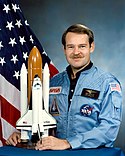John Oliver Creighton
| John Oliver Creighton | |
 NASA:s officiella porträtt på John Oliver Creighton. | |
| NASA-astronaut | |
|---|---|
| Tillstånd | Ej aktiv |
| Född | 28 april 1943 Orange, Texas |
| Tid i rymden | 16 dagar, 20 timmar, 24 minuter |
| Urvalsgrupp | Astronautgrupp 8 den 16 januari 1978 |
| Uppdrag | STS-51-G, STS-36, STS-48 |
| Uppdragsemblem | |
John Oliver Creighton, född 28 april 1943 i Orange, Texas, är en amerikansk astronaut uttagen i astronautgrupp 8 den 16 januari 1978.
Rymdfärder
Källor
”Biographical Data” (på engelska) (PDF). NASA. december 1994. https://www.nasa.gov/wp-content/uploads/2016/01/creighton_john.pdf?emrc=9b212e. Läst 10 maj 2024.
Media som används på denna webbplats
Shuttle mission 51-G patch
- The STS-51G insignia illustrates the advances in aviation technology in the United States within a relatively short span of the twentieth century. The surnames of the crewmembers for the Discovery's mission appear near the center edge of the circular design.
John Oliver Creighton
STS-36 Mission Insignia
STS-48 Mission Insignia
- Designed by the astronaut crewmembers, the STS 48 patch represents the Space Shuttle Orbiter Discovery in orbit about the Earth after deploying the Upper Atmospheric Research Satellite (UARS) depicted in block letter style. The stars are those in the Northern Hemisphere as seen in the fall and winter when UARS will begin its study of Earth's atmosphere. The color bands on Earth's horizon, extending up to the UARS spacecraft, depict the study of Earth's atmosphere. The triangular shape represents the relationship among the three atmospheric processes that determine upper atmospheric structure and behavior: chemistry, dynamics and energy. In the words of the crewmembers, This continuous process brings life to our planet and makes our planet unique in the solar system."




